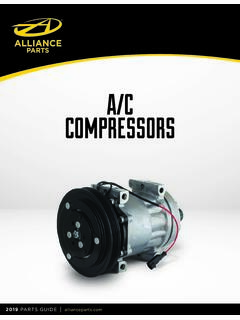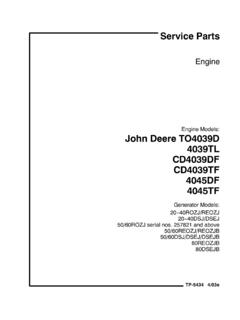Transcription of Standard Operating Procedure (SOP) Compressed Gas ...
1 Standard Operating Procedure (SOP) Compressed Gas Cylinders (Original SOP from Eastern Washington University) Page 1 of 1 INTRODUCTION Compressed gases can be toxic, flammable, oxidizing, corrosive, inert, or some combination of these haza rds. In addition to the chemical hazards, the amount of energy resulting from the compression of the gas makes a Compressed gas cylinder a potential rocket. Appropriate care in the handling and storage of Compressed gas cylinders is essential. The following are six general recommendations. and Understand Gas Properties: Know and understand the properties, uses, andsafety precautions before using any gas or gas mixture. Consult the Safety DataSheets (SDS) for safety information on the gases that you will be Check Equipment: Leak test lines and equipment before they are used.
2 Lines andequipment should be designed and maintained to handle full cylinder pressure. Materialsof construction should be compatible with the gases being Develop Emergency Plans: Be aware of potential hazards and develop plans to cover allpossible emergencies. Include information about the types of gases used on yourlaboratory s Emergency Information Personal Protection: Wear suitable protective clothing, including gloves and faceprotection. Stay well informed of the potential hazards of the gases with which you Follow Regulations: Follow all federal, state, and local regulations pertaining to thestorage and use of Compressed gas cylinders. Follow the National Fire ProtectionAssociation (NFPA) codes, especially for flammable in Doubt, Contact EOHS: If you are unfamiliar with the hazards associated with a particular gas or unsure of the correct handling and storage procedures, call EOHS at HAZARDS The following is an overview of the primary hazards to be avoided when handling and storing Compressed gases.
3 (Note: Cryogenic liquids and cylinders are covered under the Cryogenic SOP). Asphyxiation: Simple asphyxiation is the primary hazard associated with inert gases. Because inert gases are colorless and odorless, they can escape into the atmosphere undetected and quickly reduce the concentration of oxygen below the level necessary to support life. Fire and Explosion: Fire and explosion are the primary hazards associated withflammable gases, oxygen, and other oxidizing gases. Flammable gases can be ignited bystatic electricity or by a heat source, such as a flame or a hot object. Oxygen and otheroxidizing gases do not burn, but will support combustion of flammable the concentration of an oxidizer accelerates the rate of combustion. MaterialsStandard Operating Procedure (SOP) Compressed Gas Cylinders Page 2 of 2 that are nonflammable under normal conditions may burn in an oxygen-enriched atmosphere.
4 Chemical Burns: Corrosive gases can chemically attack various materials, including fire-resistant clothing. Some gases are not corrosive in their pure form, but can becomeextremely destructive if a small amount of moisture is added. Corrosive gases can causerapid destruction of skin tissue. Chemical Poisoning: Chemical poisoning is the primary hazard of toxic gases. Even invery small concentrations, brief exposure to these gases can result in serious poisoninginjuries. Symptoms of exposure may be delayed. High Pressure: All Compressed gases are potentially hazardous because of the highpressure stored inside the cylinder (even low pressure cylinders). A sudden release ofpressure can cause injuries by propelling a cylinder or whipping a line. Improper Handling of Cylinders: Compressed gas cylinders are heavy and awkward tohandle.
5 Improper handling of cylinders could result in sprains, strains, falls, bruises, andbroken bones. Other hazards such as fire, explosion, chemical burns, poisoning, and coldburns could occur if gases accidentally escape from the cylinder due to , STORAGE, AND USE OF GASES Only persons familiar with the hazards should handle Compressed gas cylinders. Reduce the pressure of a Compressed gas through a manufacturer's specified regulator attached to the cylinder valve. Test cylinders for leaks each time you use them. Use an appropriate leak-test solution or detection equipment to check for leaks, never use flame. Make sure the solution is compatible with the gas being tested. Refer to the drawing on the right for examples of areas to test. Service pressure in PSIM aterial of the tank 3AA, Steel 3Al, Aluminum Standard Operating Procedure (SOP) Compressed Gas Cylinders Page 3 of 3 All cylinder movement should be done Always secure the cylinders with a Compressed gas cylinder cart.
6 When in storage or use. Cylinders secured with a chain or strap must have the chain or strap attached 2/3 of the way up on the cylinder . Compressed gas cylinders should not be subjected to any mechanical shock that could cause damage to their valves or pressure relief devices. Cylinders should not be dropped, dragged, slid, or used as rollers for moving material or other equipment. cylinder caps perform two functions. First, they protect the valve on the top of the cylinder from damage if it is knocked over. Second, if gas is accidentally released through the valve, the cap will vent the gas out of both sides, minimizing the likelihood that the cylinder will topple. cylinder caps should not be removed until the cylinder is secured in place and ready for use. REGULATOR SELECTION Check the regulator before attaching it to the cylinder .
7 Be sure you are using the proper regulator for the particular gas that is inside the cylinder . If the regulator connections do not readily fit together, the wrong regulator is being used. Do not force connections to fit, as you may permanently damage the threads. See Regulator Selection, Installation, and Operation cylinder STORAGE PRECAUTIONS Several precautions should be taken during storage of Compressed gas cylinders. Full and empty cylinders should be stored separately. Cylinders should be stored upright and secured at all times. Cylinders should not be stored near radiators or other heat sources. Gases should be used and stored only in a well-ventilated area. Never store gases for longer than one year without use. Always screw on an appropriategas cap on cylinders that are not in use.
8 Protect cylinders from corrosion due to weather or chemicals. Gases should be stored in the order in which they are received and will be used. When in storage, empty or full the caps must be on and the labels viewable. Segregate empty cylinders from full cylinders. It is essential that when handling or storing cylinders containing toxic or corrosive gasesthat the plug or cap nut is always replaced in the valve outlet when the cylinder is not inuse or connected to an operational system. Use tables 1 and 2 below for proper segregation and storage Operating Procedure (SOP) Compressed Gas Cylinders Page 4 of 4 ** Gas cabinet required or exhausted directly outdoors or to exhaust hood. Standard Operating Procedure (SOP) Compressed Gas Cylinders Page 5 of 5 Oxidizers and flammable gases should be kept at least 20 ft.
9 Away from combustiblematerials and/or incompatible gases or substances. Storage areas that have a non-combustible wall at least 5 ft. in height and with a fire resistance rating of at least 30minutes may be used to segregate gases of different hazard classes in close proximity toeach other. Toxic/Poison gases must be stored in a chemical fume hood or in a properly ventilatedgas cabinet. Inert gases are compatible with all other gases and may be stored (H2) Hydrogen is a colorless, odorless, tasteless, highly flammable, and nontoxic gas. Due to this highflammability of hydrogen (lower flammable limit of 4% by volume) special safety precautions inaddition to the safety precautions mentioned above must be taken: Hydrogen gas should never be stored near oxygen, chlorine, or other oxidizing gases.
10 Thesematerials must be separated by at least 20 feet or an appropriate gas cylinder cabinet must beused. Cylinders must be located at least 25 feet from open flames, ordinary electrical equipment, and/orany ignition source. Hydrogen gas must never be stored below grade, or below the ground of the terrain whichsurrounds the building. Labels identifying cylinders as "Hydrogen" must be visible and free of obstructions. When attaching a regulator or control valve do not partially open, or 'crack', the hydrogencylinder valve. This may lead to self-ignition of the SIZESHigh Pressure Steel Low pressure steel and aluminum (AL) Order the smallest possible cylinder for your work. Gas cylinders must be inspected at least every five years by the distributor or manufacture. Lecture bottle Standard Operating Procedure (SOP) Compressed Gas Cylinders EWU EH&S SOP Page 6 of 6 6/30/14 LABEL EXAMPLES 1 Dangerous Goods Classification (Hazard Class) 2 Contents of cylinder at Standard temperature and pressure (15 C @ kPa) 3 cylinder size 4 United Nations numbering system for safe handling, transport and storage 5 Gas name and grade 6 Nominal filling pressure at Standard conditions (for permanent gas) 7 Caution - indicated major hazards* 8 General safety information* *Always refer to Safety Data Sheets (SDS) May cause cancer, fertility issues, or organ damage Causes serious eye or skin irritation Corrosive Other hazard classes that can be encountered Labels must always be visible to identify the contents of the cylinder .



